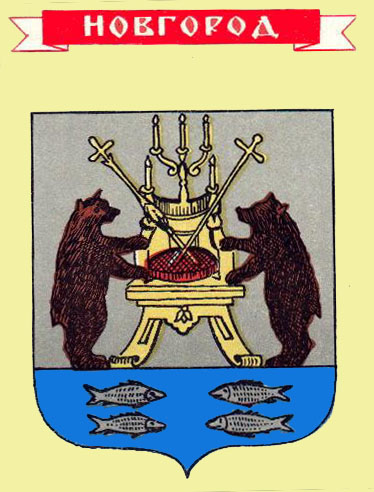| |
Photo
|
Description
|
|
|
 |
Entrance to the kremlin across a
dry moat.
|
|
| |
 |
Diagram of the kremlin on board
near entrance
|
|
| |
 |
Another diagram of the kremlin
|
|
| |
 |
The section of the restored
kremlin wall on the south west side to the right as one enters the grounds.
|
|
| |
 |
One of the Novgorod kremlin
towers under repair.
|
|
| |
 |
Section of kremlin wall from
inside the kremlin.
|
|
| |
 |
Section of wall being repaired.
|
|
| |
 |
Section of the Novgorod kremlin
wall along the Volkov on the south east end of the old town. The WWWII victory
monument is between it and the river.
|
|
| |
 |
Section of the kremlin wall along
the river
|
|
| |
 |
Another section of the kremlin
wall with tower.
|
|
| |
 |
Section of the wall and tower
just to the right of the entrance gate - the south east side of the kremlin.
|
|
| |
 |
The tower in the southwest wall
|
|
| |
 |
The tower in the southwest wall
|
|
| |
 |
Reeconstruction of cover over the
parapet of a curtain wall.
|
|
| |
 |
The millennium monument
|
|
| |
 |
Section from the millennium
monument
|
|
| |
 |
St Sophia (Holy Wisdom) Cathedral
completed in 1050. The famous Magdeburg doors are cast bronze works of
world-class art. See extensive historical discussion at
Sophia.
|
|
| |
 |
St Sophia (Holy Wisdom) Cathedral
completed in 1050.
|
|
| |
 |
Bells in front of the belfry in
the kremlin
|
|
| |
 |
Belfry
|
|
| |
 |
Belfry
|
|
| |
 |
Inside of the kremlin wall
|
|
| |
 |
Tower in Yuriev monastery outside
Novgorod.
|
|
| |
 |
Church of the Intercession with
the Pokrovski tower behind it.
|
|
| |
 |
Church of the Intercession
against the kremlin wall.
|
|
| |
 |
The upper part of the bell tower
appears above the kremlin wall in this picture taken just outside the wall by
the bank of the Volkov.
|
|
| |
 |
This set of arches is all that
remains of the merchant stall section in the trader's quarter across the Volkov
from the Novgorod kremlin. The standard design was created during the reign of
Catherine II and applied to many towns in Russia. Behind it some of the many
churches in this part of town now like an architectural park are visible. The
area was built up with wooden edifices and streets paved with split logs. The
tall tower with scafolding is the Veche tower.
|
|
| |
 |
The long white building with two
arches was a merchant arcade. The tall tower above it with scafold is the
'veche' tower in which the city veche met. The white bell tower was built in
the 17th century;. To the left rear is the Church of the Myrrh bearing women.
|
|
| |
 |
On the left the Church of the
Myrrh Bearing Women (1510) and in the center at17th century bell tower at the
end of the merchant's arcade.
|
|
| |
 |
One of the oldest churches in
Novgorod is the Church of the Assumption (Uspenski) founded in 1135-44 by
Vsyevolod before he was forced out of Novgorod, It was restored in the 15th
century
|
|
| |
 |
Church of St Paraskeva Pyatnitsa
founded in 1207 by a Novgorodian merchant guild. It was rebuilt in 1345. It is
in the Yaroslav court. The tower on the right is believed to be the veche
tower.
|
|
| |
 |
Church of St Ioan (1127 rebuilt
1453)
|
|
| |
 |
Church of St Ioan built in
1127-30 and rebuilt in 1453. This is in the church complex on the merchant side
(Yaroslav's court) across the Volkov from the kremlin.
|
|
| |
 |
Church of the Myrrh bearing women
- Zhon Mironosets - 1510. also across the Volkov in the Yaroslav court section
|
|
| |
 |
The Church of the Myrrh- Bearing
-Women - (1508-1510) It was built at the expense of Moscow Merchant, Ivan
Syrkov. In comparison with St Procopius built by his son, Dmitri, it is archaic
masive in construction and the moret elaborate. It has four supporting pillars
surrounded by a gallery. The north gallery has pentagonal niches added in the
16th century.
|
|
| |
 |
Church of the Transfiguration -
Spasopreobrazhenski - 1374 with 14th century frescoes attributed to Theophanes
the Greek.
|
|
| |
 |
Cathedral of the Apparation of
the Cross
|
|
| |
 |
Yuriev Monastery - Cathedral of
St George. This was founded in 1119 by Prince Vsyevolod and is a marvel next
only to St Sophia in the kremlin.
|
|
| |
 |
Yuriev Monastery - Church of the
Elevation of the Cross - 1828.
|
|
| |
 |
Yuriev Monastery
|
|
| |
 |
Aerial view of the Yur'yev
Monastery south of Novgorod on the bank of the Volkov River. The bell tower was
built in 1842 by Karl Rossii.
|
|
| |
 |
Cathedral of St George in the
Yuriev Monastery outside Novgorod was dedicated in 1119.
|
|
| |
 |
Raising water the old fashioned
way outside Novgorod.
|
|


